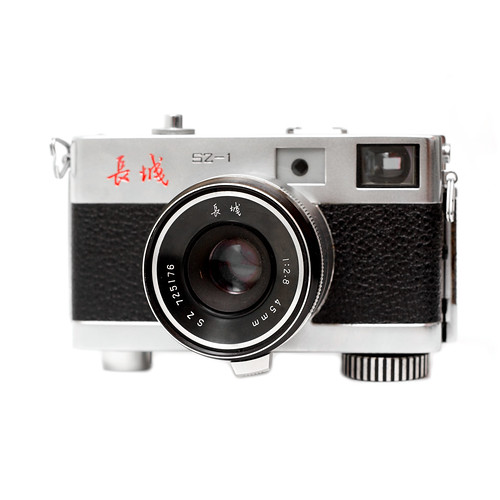Difference between revisions of "Great Wall SZ-1"
m (→Notes: latter not former) |
m (SS-2 changes) |
||
| Line 17: | Line 17: | ||
}}{{brl}} | }}{{brl}} | ||
| − | More than 100.000 of the '''Great Wall SZ-1''' [[rangefinder camera]]s with spring motor film advance were made from 1969 to 1977 by the [[Great Wall|Beijing Camera Factory]]. The camera has a coated f=45mm 1:2.8 lens, focusable from 0.9m to infinity aided by the [[coupled rangefinder]]. The rangefinder's split image is superimposed to the viewfinder image. Its PC [[flash sync]]hronized shutter allows speeds from 1/30 to 1/300 sec. plus B mode. The first two digits of the body's serial number indicate the year of production. After some use the cameras needed a lot of awfully complicated repair and maintenance. Thus the model was replaced in 1979 by the sturdier Great Wall '''SZ-2'''. The SZ-1 itself was preceded by a dozen hand-made similar cameras under the name '''Beijing SZ-1''' which were decorated with political slogans like ''Long Life To Chairman Mao''. The government didn't allow producution of further cameras under the name ''Beijing'' to avoid conflicts with the proud Shanghai camera makers. The camera construction was derived from a design of [[Ricoh]] - the [[Ricoh Super Shot|Super Shot]]. | + | |
| + | More than 100.000 of the '''Great Wall SZ-1''' [[rangefinder camera]]s with spring motor film advance were made from 1969 to 1977 by the [[Great Wall|Beijing Camera Factory]]. The camera has a coated f=45mm 1:2.8 lens, focusable from 0.9m to infinity aided by the [[coupled rangefinder]]. The rangefinder's split image is superimposed to the viewfinder image. Its PC [[flash sync]]hronized shutter allows speeds from 1/30 to 1/300 sec. plus B mode. The first two digits of the body's serial number indicate the year of production. After some use the cameras needed a lot of awfully complicated repair and maintenance. Thus the model was replaced in 1979 by the sturdier Great Wall '''SZ-2''', which had an improved shutter system and a sturdier spring motor. | ||
| + | The SZ-1 itself was preceded by a dozen hand-made similar cameras under the name '''Beijing SZ-1''' which were decorated with political slogans like ''Long Life To Chairman Mao''. The government didn't allow producution of further cameras under the name ''Beijing'' to avoid conflicts with the proud Shanghai camera makers. The camera construction was derived from a design of [[Ricoh]] - the [[Ricoh Super Shot|Super Shot]]. | ||
| + | |||
{{Flickr_image | {{Flickr_image | ||
Revision as of 13:42, 10 March 2019

|
| compared w/ Ricoh Super Shot 2.4 image by phollectormo (Image rights) |

|
| image by Eduardo Urdangaray (Image rights) |
More than 100.000 of the Great Wall SZ-1 rangefinder cameras with spring motor film advance were made from 1969 to 1977 by the Beijing Camera Factory. The camera has a coated f=45mm 1:2.8 lens, focusable from 0.9m to infinity aided by the coupled rangefinder. The rangefinder's split image is superimposed to the viewfinder image. Its PC flash synchronized shutter allows speeds from 1/30 to 1/300 sec. plus B mode. The first two digits of the body's serial number indicate the year of production. After some use the cameras needed a lot of awfully complicated repair and maintenance. Thus the model was replaced in 1979 by the sturdier Great Wall SZ-2, which had an improved shutter system and a sturdier spring motor.
The SZ-1 itself was preceded by a dozen hand-made similar cameras under the name Beijing SZ-1 which were decorated with political slogans like Long Life To Chairman Mao. The government didn't allow producution of further cameras under the name Beijing to avoid conflicts with the proud Shanghai camera makers. The camera construction was derived from a design of Ricoh - the Super Shot.

|
| compared w/ Ricoh Super Shot 2.4 image by phollectormo (Image rights) |
Notes
The images compare the SZ-1 with the Ricoh Super Shot 2.4. Whilst this was similar in looks to the Super Shot (1.7), they are actually two different models, and the latter is a viewfinder rather than a rangefinder camera. Notwithstanding, the SZ-1 was quite different to the Ricoh cameras it is often contrasted with, in so much that it lacked a built-in light meter, and therefore offered no exposure automation as found in both the Super Shot and Super Shot 2.4.